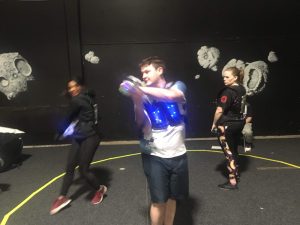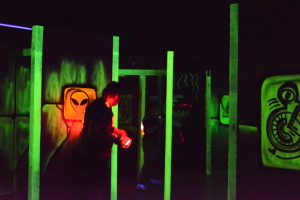Beginner Training Sessions
A brief overview of the Zone 101 training session we have been running for the last few years. This generally takes about an hour and is best run early in a new player’s career, but only after they have been playing for a few weeks. The idea is to give them a quick introduction to some important skills. New players don’t need to master anything in this session; simply understanding the mechanics will enable them to develop these skills at their own pace.

Phasor grip
On Nexus it’s important to get people into the standard grip as soon as possible (thumb on the two-hand sensor). Ideally this would be shown to the new player on their first time playing, but if they somehow snuck through with the pub grip this should be corrected first.
With Helios it can take some time to find a grip that suits you. I would still recommend the experienced players go through some common ones with the new players. An important goal is to get them holding the phasor with the top angled towards the body. This will help with cornering later. You can find the guide to Helios grips here.

Spawning/Duelling
It’s important that new players understand the start-up sequence of whatever system they are playing on. They don’t need to develop perfect timing, but they should be aware of the likely result of the spawn and when to pull the trigger for the active/deactive timing. People will develop their timing much faster if they are aware of the mechanics, rather than just slowly learning it in games.
On Nexus, what we do is explain how the timing works, and practise until they can consistently keep people down in a clean 1 on 1 (no dodging, no maze sounds, etc.). Once they can do this, it gives them the confidence to attempt it in the maze in real game conditions.
On Helios it’s a little different. Neither player has the advantage. It’s still valuable to do some timing training with the new player to make sure they know when they need to pull the trigger and can get their doubles as consistently as possible.
Hopefully by the end of this drill they will have the confidence and knowledge to attempt to challenge the more experienced players in the maze rather than being bullied out of key positions. On Nexus they should be able to keep deactive players down and on Helios they should be able to get doubles when required.

Cornering
Cornering is one of the base skills of laser tag. When new players start, they can’t shoot around a corner without exposing a lot of sensors and this puts them at a major disadvantage against more experienced players. The goal for this part of the training is to get the new players to the point where they can hold a left-handed and right-handed corner without getting shot. They don’t have to be panel masters but should be able to fend off someone coming down an open corridor.
We start by putting them on an “easy” corner and showing them a back on or side on low grip, making sure they can see around the corner without exposing anything, and then having them practice shooting someone trying to charge them down without getting hit. Once they can protect themselves we introduce a base. We put them in a take spot that can watch one door. When they are ready to start the drill they put a shot into the base. Someone will run in that door and try to deny them. When they can cleanly take the base and deal with the defender we add a second defender (both running in same door). We then repeat the whole process with the other side, where they will need to use a high grip or cross.
New players have a tendency to take the base from a corner and not watch anything. It’s MUCH harder to take a base this way, since both doors need to be clear. Once they learn basic take-and-watch, the number of take opportunities doubles. They will still get denied a lot, but so long as they are attempting this in the maze they will quickly improve.

That’s all there is to it. We’ve found that going through these exercises is really valuable for new players and definitely reduces the time it takes them to get up to speed in competitive play. It can be useful to run the whole session again with them once they’ve gained some knowledge. We’re looking at creating a Zone 201 session in the future.
